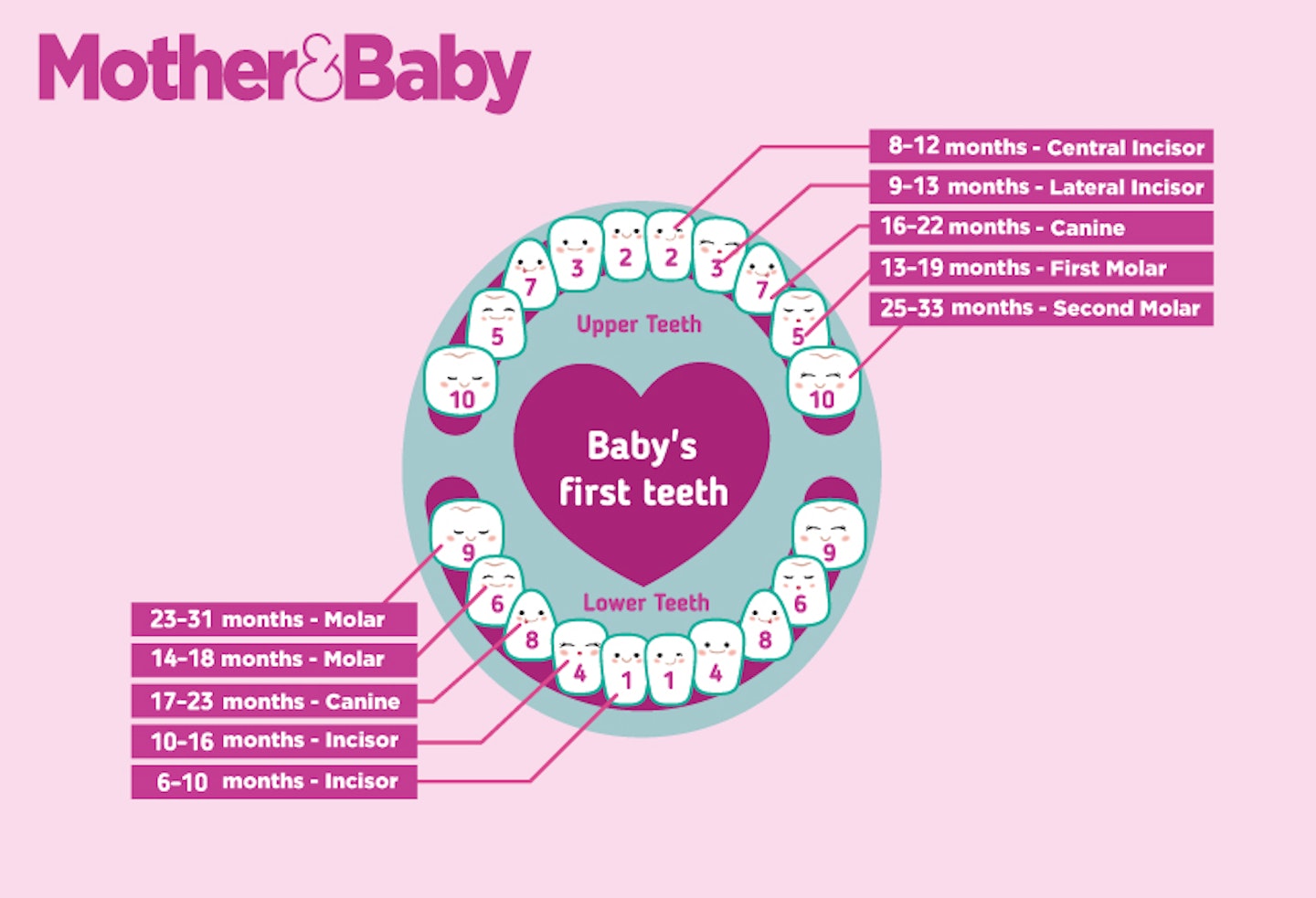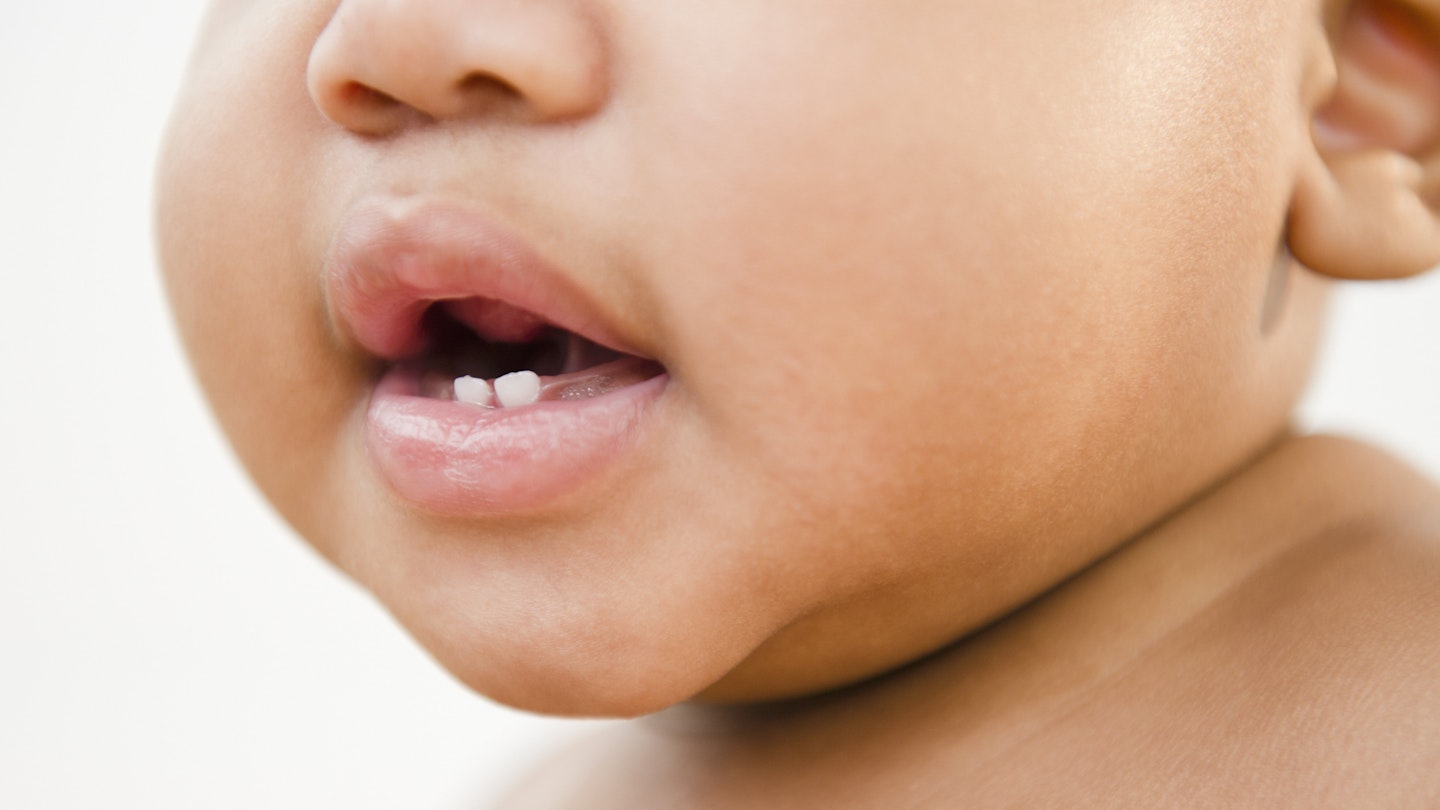All babies start teething at different rates and teething can last for different periods of time, so it's useful to know what signs to look out for when your baby starts teething and the order in which their teeth will appear, to help them through this huge baby milestone.
Teething can be painful for babies, but there are lots of ways you can help ease any discomfort. Knowing more about this milestone is a good way to be prepared.
When does teething start?
Six weeks after conception, the cells that will eventually become your baby’s teeth started to form underneath their jaw. And, as baby grew in your womb, these gradually became more solid and structured so, when they're born, they'll have a full set of teeth buds.
These continue to grow until they’re right underneath the gum line, around 3 months old, when teething symptoms normally start.
Although you may start to notice the symptoms, their first tooth can take until 6 months old, and then teething lasts until they are about 25-33 months.
It will take around eight days for the tooth to push through the gum and a few months to continue growing to full size, at a rate of 1mm a month.
With some teeth, your baby might not feel up to feeding, as the suction can make their sore gums feel worse, and if they're weaning, they might also refuse solid food. Hunger normally wins out, but if your baby is reluctant to feed for a few days give your doctor or paediatric dentist a call to check everything’s OK.
Your baby may also bite to relieve the pressure in their gums, so receiving a nip on your fingers or while you’re breastfeeding can indicate a tooth is well on its way.
Signs and symptoms of teething
When a tooth is ready to come through the gum, you’ll be able to see its white tip just underneath your baby’s gum line. Their body releases a chemical that causes their gum to become less dense, so the tooth can push through easily. But the tooth still must break through the top layer of her gum, which can cause some discomfort.
Here’s some early teething symptoms to watch out for, so you’re ready to ease a tooth’s arrival.
• Irritability
• 1 flushed cheek
• Red and sore looking gum where the tooth is coming through
• A mild temperature of 38C
• Ear rubbing
• Biting
• Excess saliva production (using a bib will help prevent teething rash)
• Dribbles
• Rubbing cheeks
• Not sleeping well
• Refusing to eat
What order do baby teeth come in?
You’ll find that they react differently to these teeth types coming through – what soothes an incisor might not work so well on a molar, which is why it’s great to have lots of ways to help your baby. Her front teeth have flatter, thinner edges and tend to slide through her gums so are usually the easiest to cut.
This baby teeth order chart shows when your baby’s teeth will emerge.

1.) Lower central incisors - although you may notice the first signs of teething around the three or four months old mark the first teeth, these two front bottom teeth, can emerge as late as six months.
2.) Upper central incisors - the upper middle teeth come next. You can usually expect them a month after the bottom two.
3.) Upper and lower lateral incisors - at nine to 12 months your baby can expect four more teeth, one on either side of these central teeth, and these are her lateral incisors.
4.) First molars - these will appear at around 14 months at the top and bottom of your baby’s mouth, leaving a gap between them and her incisors.
5.) Canine teeth - at 18 months these four sharper teeth will emerge in the gaps between the incisors and first molars.
6.) Seconds molars - these will emerge at the back of her mouth at around 26 months.
Remember, the age babies teeth come through varies a lot, but you can expect your little one to have a full set of baby teeth by the time they turn three. If she reaches her first birthday without any teeth emerging, then it’s a good idea to visit your dentist.
How to soothe teething pains
Some babies might have all these symptoms, while others may sail through without a sign. And some teeth might cause a run of restless nights, while others will pop up one morning without warning.
There are lots of teething remedies that will help your baby when they need it, from teething rings to gels, and the secret is to experiment and mix and match your methods with each new tooth to find what really works.
Teething toys
• Experiment with teething toys to find one that offers just the right pressure to ease discomfort. And have a selection of different shapes too: circular teethers are best when they're cutting their front teeth but they’ll need a longer, thinner design to reach their molars.
• The nobbly bits on teethers can provide extra relief and will give your baby’s gums something to grasp onto. Buy one with a range of textures so she can experiment for herself.
• A teething necklace can also be a great option for on the go.

Pain relief
• You can give your baby paracetamol from two months and ibruprofen from three months but whichever brand you choose, make sure it is suitable for babies.
• Paracetamol is best for relieving mild to moderate discomfort before a tooth comes through. When your baby is actually cutting a tooth, ibruprofen is more effective as it helps reduce inflammation. Always give the recommended dosage and check with your doctor if you’re not sure.
• Another pain relief option are teething granules, which contain a natural pain reliever to ease discomfort and easily dissolve in your baby’s mouth.
• Teething gels can also help ease discomfort as they contain a small dose of antiseptic which will help numb baby's gums, but make sure you use one that is suitable for babies.
Teething tips
• To numb your baby’s gums, give them a teether that’s been chilled in the fridge for half an hour. Or if they’re over six months, offer some cold water in a cup.
• Give your baby a clean flannel soaked in warm water to suck on - the warmth can ease aching gums and help teeth break through the gums.
• Depending on your baby's age, feed chilled fruit purées or pop a chunk of frozen banana or plums in a baby feeder mesh bag for them to gnaw on safely.
• The crook of your little finger makes a great teether – but do wash your hands first. And, if she’s restless at night, gently press on her gum with your little finger – it’s a great way to soothe her without waking her up.
• Give your baby lots of extra cuddles and kisses as teething can be a really unsettling time and she’ll need lots of love and reassurance, don't worry the baby smiles will be back soon!
Watch the video below for more teething tips from Emily Norris:
When should babies have their milk teeth?
By the time they're around two and a half, your little one is likely to have their full set of 20 baby teeth.
Looking after your baby's teeth
You can start brushing your baby's teeth as soon as they start to come through. Use a baby toothbrush with a tiny smear of fluoride toothpaste.
Don't worry if you don't manage to brush much at first. The important thing is to get your baby used to brushing their teeth as part of their daily routine. You can help by setting a good example and letting them see you brushing your own teeth.
About the author
Emily Gilbert is the Features & Reviews Editor for Mother&Baby and has written for the website and previously the magazine for six years. Specialising in product reviews, Emily is the first to know about all the exciting new releases in the parenting industry.
